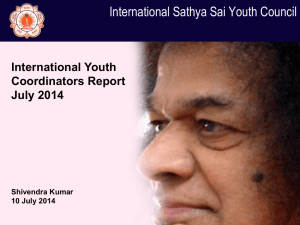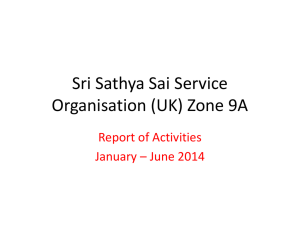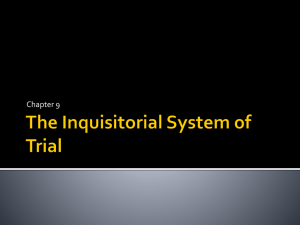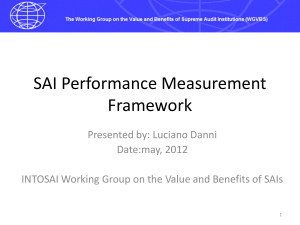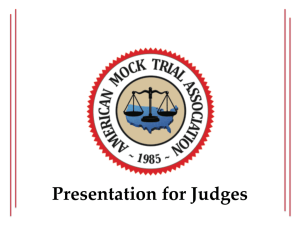Protecting Eyewitness Evidence
advertisement
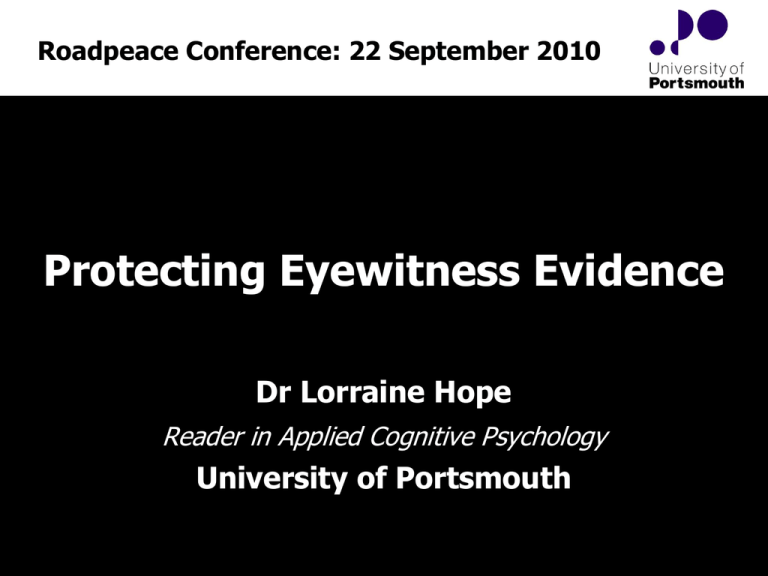
Roadpeace Conference: 22 September 2010 Protecting Eyewitness Evidence Dr Lorraine Hope Reader in Applied Cognitive Psychology University of Portsmouth Investigations: Incidents, crimes, crashes Investigations • Investigations are an attempt to reconstruct a past event, incident or episode: • Physical evidence (fibers, DNA, skid marks, impact analyses) • protocols for collecting, preserving and interpreting physical evidence • Optimal ways to avoid contamination • Physical evidence is often ‘circumstantial’ • Witness evidence (memory & ID) • Typically collected by non-specialists in human memory • Protocols for collecting, preserving and interpreting eyewitness evidence has not always incorporated scientific research • Can directly link a particular suspect to an incident Memory as (Re)Construction Recall - not an exact replica of original events Recall - a construction built and rebuilt from various sources Reconstruction process = vulnerability to error & suggestion Vulnerability can be reduced by ‘careful handling’ of memory by investigators When are witness memory errors most likely? When original memory trace is weak Poor encoding of incident Delay Forgetting results in ‘gaps’ or a hazy recollection Misinformed by a co-witness At the scene or subsequently (multiple retellings & elaboration) Exposure to misleading press/media Misleading questions Poor interview technique (formal or informal interviews) Delay and Decay: Does it matter? • Empirical evidence for rapid memory decay – steep forgetting curve Forgetting Curve Memory Decay: What does the research show? • Completeness & accuracy of recall decreases as the delay between witnessing & recall increases (Penrod et al., 1982; Wixted & Ebbesen, 1991, 1997) • Mock witnesses recalled 43% fewer details after a 3-week delay before being interviewed (Turtle & Yuille, 1994) • Information less accessible as memory traces (and associations between traces) are weakened (Ayers & Reder, 1998) • Memory fades from the specific to the general or gist (Goldsmith et al., 2005) Consider the Problem.. Serious incident: multiple witnesses Limited resources = delay before full interview During this period, eyewitness memory is: i) prone to decay ii) vulnerable to the influence of post event information Immediate recall as a solution? • A (good quality) initial recall attempt has positive effects on memory: – Retrieval activates memory traces & strengthens associations between them – A recall attempt prior to misleading PEI (post event information) can help protect the original memory Consider the Problem… Serious incident: multiple witnesses Limited resources = delay before interview Solution? A system or tool that allows witnesses to record their own memories shortly after encoding Our objective? Develop a ‘Self-Administered Interview’ (SAI) – A self-explanatory recall tool for witnesses to complete themselves as soon as possible after witnessing a crime or incident requiring further investigation The ‘Self-Administered Interview’ • A recall tool to facilitate witnesses when remembering & reporting information, comprising; – Carefully designed information regarding what is expected from witnesses – Guidelines and questions that provide retrieval support – Adapts components of the ‘gold standard’ Cognitive Interview: • Mental Reinstatement of Context • Report Everything – Spatial layout/sketch element Study 1: Developing & Testing the SAI Aims 1. Identify optimal SAI format 2. Compare with other recall methods Experimental Conditions 1. Free Recall 2. SAI 3. Cognitive Interview (self-administered) (self-administered) (interviewer-administered) – General public recruited to act as witnesses (N=55). – Viewed simulated non-violent video event (2mins 40secs). Results Control 24 CI 10 2 6 47 SAI 42 0 20 16 7 10 People* Actions* Setting* Objects 5 8 10 20 30 40 50 60 70 80 90 100 Mean no. of details reported Overall Correct items: F (2,54) = 24.72, p < .001 No difference in accuracy rates (>90% in all groups) Study 2: Incorporating a delay • General public recruited to act as witnesses (N=42). • Allocated to SAI or Control condition. Session 1 – All pps viewed simulated crime event on video – SAI participants record recall after event Delay = 1 week Session 2 – All participants provide full free recall Results (Delay = 1 week) 37 SAI 12 4 9 People* Actions Setting Objects Control 23 0 10 12 20 30 3 7 40 50 60 70 Mean no. of details reported Total correct: F (1,40) = 5.41, p = .02 No difference in Incorrect or Confabulated responses Summary of main findings • SAI strengthens memory for a witnessed event • SAI instructions produce significantly more information than a free recall (‘tell me what you saw’) instruction • Subsequent studies confirmed that completing an SAI after witnessing a crime – – – – Minimises forgetting over a delay Maintains high accuracy rates Enhances performance in a subsequent CI Protects against memory distortions caused by exposure to misleading questions and PEI Field Trials Question: Does the SAI deliver in the field? Objectives: 1. Examine the quantity & quality of information provided by witnesses using the SAI 2. Gauge ‘usability’ of the SAI by witnesses and officers, to lead future development of the tool 3. Identify witnessing contexts in which the SAI provides most benefit to police investigation (e.g. multiple witnesses, peripheral witnesses, etc.) Field Studies of the SAI endorsed by ACPO Case study: Greater Manchester Case study • Perpetrators – 3 males on a motorbike, collide with a car at 60mph – Passengers thrown from bike and hit a bus – 1 fatality, 1 seriously injured, rider tries to escape scene • Investigating officers (x 2) • Witnesses (x 16) – 8 witnesses interviewed by police shortly after the collision – SAI administered to 8 witnesses Quantity & quality of information obtained • 88% of selected witnesses completed an SAI. • Of these: – All witnesses gave a detailed free recall account of the incident (average of 54 lines of text / 2.5 A4 pages of info.) – In addition, most witnesses completed all other relevant sections of the SAI, providing information about: • Perpetrators’ actions & descriptions • The quality of their own view/testimony • Other potential witnesses who had been present – 5 witnesses provided a sketch, appended with descriptors • SAI identified three additional important witnesses Quantity & Quality of SAI information • Reports were detailed: – "Male, white, shaved head, wearing long sleeved jumper and balaclava, 20 years old, around 11 stone, no facial hair, olive skin, cut on his head” – "The motorbike had three riders, they seemed to be sitting in height order with the smallest at the front. I noticed that they were riding at speed on the wrong side of the road and overtaking the slower traffic. None of the riders were wearing helmets, instead they had their faces covered, in an intimidating manner with balaclava type clothing" • High level of corroboration between statements End user evaluation from investigators • Usability was evidenced by proper use and understanding of instructions for use. • Feedback from the investigating officers: “Out of all the SAIs issued only one person failed to complete the form. The forms that were completed were comprehensive, and a few I would say were more detailed and beyond the standard that some officers sometimes produce. Many contained useful detail in proving the case, and in the case of one witness, crucial evidence in terms of the rider and passengers’ actions leading up to the event which without doubt will show the joint venture in this case. The SAI forms have led to another three crucial statements being taken.” Use of the SAI within force • Adopted as force form by Greater Manchester Police. Summary of main findings • The SAI is a standardised, empirically tested witness reporting tool – Based on sound theoretical principles of memory – Allows numerous witnesses to give evidence simultaneously and efficiently – Elicits forensically relevant information with high level of detail from witnesses – Facilitates the effective prioritisation of witness statements • Applied Caveats: - Not suitable for all crimes or incidents - Not suitable for all witnesses (foreign language, literacy, social support/vulnerable) Conclusions • Witness memory for any incident is vulnerable to both decay and distortion • SAI offers clear benefits for quality and quantity of information provided in witness accounts – Distinct from previous reporting forms, based on psychological principles of Cognitive Interviews and empirically tested • SAI – part of an investigations toolbox - Preserves and protects witness memory and elicits timecritical information effectively Dr Lorraine Hope University of Portsmouth lorraine.hope@port.ac.uk Acknowledgements The British Academy & ESRC


